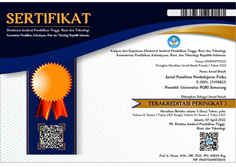Design of Website-Based Learning Media to Enhance Critical Thinking Skills in Static Fluid Concepts
DOI:
https://doi.org/10.26877/jp2f.v16i3.2258Keywords:
learning media, website, critical thinkingAbstract
Critical thinking skills are one of the 21st-century skills that students must have, and the rapid development of technology provides a demand to develop a learning medium that facilitates this. Therefore, the purpose of this research is to create a website-based learning media design oriented to critical thinking skills on static fluid material. The research utilises the Successive Approximation Model (SAM) for its development. The research model consists of a preparation phase, an iterative design phase, and a final phase. The preparation phase is the initial stage to efficiently collect background information on the problem. The iterative design phase consists of design cycle activities, prototyping, and reviewing. The iterative design phase includes the process of developing, implementing, and evaluating learning media continuously. The research participants consisted of lecturers, prospective teachers, teachers, and students. The feasibility of the website was analysed in terms of material and media, which was conducted twice by six validators. In the first stage, the feasibility of the website in terms of material and media was declared "Feasible" with a V-aiken score of 0.600. After making improvements, the website was revalidated with a V-aiken score of 0.926 with the category "Feasible". Students' responses to the developed website were positive. The website's readability is excellent. This website-based learning media has contributed to meeting the demands of students' critical thinking skills.
References
[1] Khairul Umam 2021 Kurikulum dan Tuntutan Kompetensi Abad 21 Nusantara: Jurnal Pendidikan Indonesia 1 511–26
[2] Redhana I W 2019 Mengembangkan Keterampilan Abad Ke-21 Dalam Pembelajaran Kimia Jurnal Inovasi Pendidikan Kimia 13 2239–53
[3] R. H. Ennis 2011 An Outline Of Critical Thinking Disposition And Abilities (Urbana–Champaign: University Of Illinois)
[4] King F, Goodson L and Faranak Rohani M 2010 Higher Order Thinking Skills (Washington, DC: Assessment Dan Evaluation Educational Service Program)
[5] Asniar, Nurhayati and Khaeruddin 2022 Analisis Keterampilan Berpikir Kritis Dalam Pembelajaran Fisika Peserta Didik Di SMAN 11 Makassar Jurnal Sains dan Pendidikan Fisika (JSPF) 18 140–51
[6] Ardiyanti F and Nuroso H 2021 Analisis Tingkat Keterampilan Berpikir Kritis Siswa Kelas XI MIPA Dalam Pembelajaran Fisika Karst : Jurnal Pendidikan Fisika dan Terapannya 4
[7] Susilawati E, Agustinasari A, Samsudin A and Siahaan P 2020 Analisis Tingkat Keterampilan Berpikir Kritis Siswa SMA Jurnal Pendidikan Fisika dan Teknologi 6 11–6
[8] Permata R A, Muslim and Suyana I 2019 Analisis Kemampuan Berpikir Kritis Siswa SMA Pada Materi Momentum Dan Impuls Prosiding Seminar Nasional Fisika 8
[9] Setyadi D and Qohar A 2017 Pengembangan Media Pembelajaran Matematika Berbasis Web pada Materi Barisan dan Deret Kreano 8 1–7
[10] Pratama W A, Hartini S and Misbah 2019 Analisis Literasi Digital Siswa Melalui Penerapan E-Learning Berbasis Schoology Jurnal Inovasi dan Pembelajaran Fisika 6 9–13
[11] OECD 2015 Programme for International Student Assessment Result for PISA 2015 (Paris: OECD Publishing)
[12] Shabudin M, Aisyah A, Darus S and Mimiko N 2014 Development of Teaching Materials and Utilization of Web 2.0 in Japanese Language Teaching and Learning Procedia Soc Behav Sci 118 433–41
[13] Cahyani H, Samsudin A, Tarigan D E, Kaniawati I, Suhendi E, Suyana I and Danawan A 2019 Identifikasi Miskonsepsi Fluida Statis Pada Siswa SMA Menggunakan Four-Tier Diagnostic Test Prosiding Seminar Nasional Fisika 5.0 114–24
[14] Dhitareka P H, Hidayat A and Siahaan P 2022 Comparison of Nature of Science Profile in Indonesia, Malaysia, and Singapore Secondary Science Textbooks: Case of Electricity Lesson Jurnal Penelitian Pendidikan IPA 8 2299–306
[15] Richard Paul and Elder L 2006 The Miniature Guide to The Foundation for Critical Thinking Concepts and Tools (Dillon Beach, California: Foundation for Critical Thinking Press)
[16] Hidayat A 2019 Technological Pedagogical Content Knowledge (Tpack) Instrument For Indonesia Science Pre-Service Teacher: Framework, Indicators, And Items Development Unnes Science Education Journal 8 155–67
[17] M. W. Allen and R. Sites 2012 Leaving ADDIE for SAM, (Alexandria, Virginia: ASTD Press)
[18] Arif Hidayat 2019 Developing And Validating A Technological Pedagogical Content Knowledge (TPACK) Instrument For Secondary Unnes Science Education Journal 8 31–40
[19] W. D. A. Suladi and K. Biskoyo 2000 Keterbacaan Kalimat Bahasa Indonesia dalam Buku Pelajaran SLTP (Jakarta: Pusat Bahasa Departemen Pendidikan Nasional)
[20] R. C. Clark and R. E. Mayer 2016 E-Learning And The Science Of Instruction: Proven Guidelines For Consumers And Designers Of Multimedia Learning (San Francisco: Pfeiffer)
[21] J. Nesbit, K. Belfer and T. Leacock 2007 Learning Object Review Instrument (LORI) User Manual V 1.5 (Surrey, British Columbia: E-Learning Research and Assessment Network)
[22] Herliana F, Mardila R, Mahzum E, Wahyuni A and Muliyati D 2025 The Effect of Web-based Inquiry Physics Problems on High School Students’ Physics Learning Outcomes 13 206–24
[23] Sujanem R and Suwindra I N P 2023 Problem-Based Interactive Physics E-Module In Physics Learning Through Blended Pbl To Enhance Students’ Critical Thinking Skills Jurnal Pendidikan IPA Indonesia 12 135–45
[24] Weng X, Cui Z, Ng O-L, Jong M S Y and Chiu T K F 2022 Characterizing Students’ 4C Skills Development During Problem-based Digital Making J Sci Educ Technol 31 372–85





